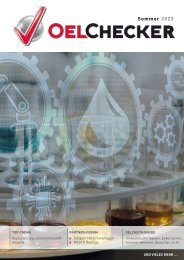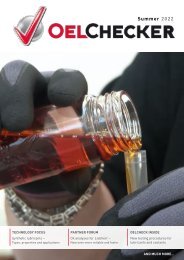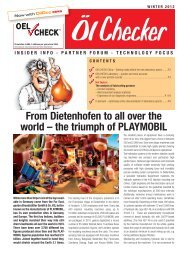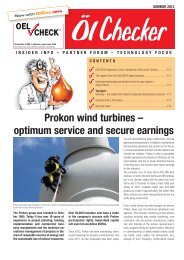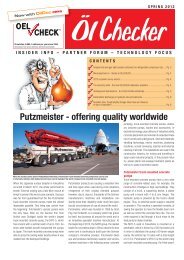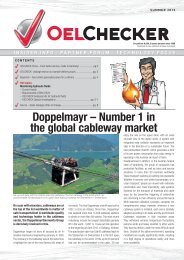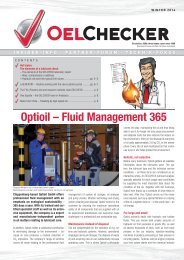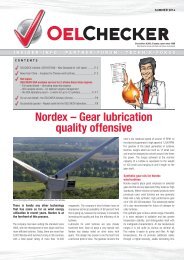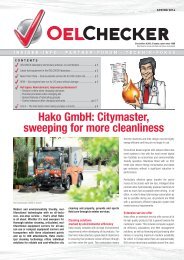OELCHECKER - Spring 2013
> Editorial – OELCHECK takes decisive steps for the years to come > OELCHECK – A strong brand with a new look > New services offered by the OELCHECK laboratory > Lubricants and condition monitoring – OELCHECK recognises trends > Gas engine oils – Latest information on oxidation determination > China – Opening of the OELCHECK laboratory in Guangzhou > Q & A – How can there be high levels of wear metals with normal purity classes? > OilDoc news
> Editorial – OELCHECK takes decisive steps for the years to come
> OELCHECK – A strong brand with a new look
> New services offered by the OELCHECK laboratory
> Lubricants and condition monitoring – OELCHECK recognises trends
> Gas engine oils – Latest information on oxidation determination
> China – Opening of the OELCHECK laboratory in Guangzhou
> Q & A – How can there be high levels of wear metals with normal purity classes?
> OilDoc news
- No tags were found...
Create successful ePaper yourself
Turn your PDF publications into a flip-book with our unique Google optimized e-Paper software.
OELCHECK INSIDER INFO<br />
OELCHECK – A strong brand with a new look<br />
After more than 20 years, it was time to give a fresh look to the OELCHECK logo and all<br />
other design elements. After all, our brand presence should clearly communicate the<br />
services and values of our company.<br />
From now on, our brand presence will be much more eye-catching and dynamic than before. With its clear<br />
shapes, attractive colours and lucid layout, the OELCHECK design is unmistakable.<br />
Even the popular „Oil Doctor“, with his aura of experience, now looks as young and active as he is in reality.<br />
You can get acquainted with him on the front page of this issue of <strong>OELCHECKER</strong>.<br />
Meet us at Bauma:<br />
Hall A4, Stand 531<br />
He is making his grand appearance Bauma stand in Munich.<br />
We cordially invite you to visit us at Stand 531 in Hall A4.<br />
Transformer oil furan determination indicates the condition of the insulating paper<br />
Lab Manager Jan Hubrig starts a furan determination.<br />
Direct contact between the copper wires of<br />
a transformer, which would lead to failure, is<br />
prevented by insulating paper.<br />
In order to assess the remaining<br />
service life of the transformer,<br />
a paper sample can be removed<br />
and analysed after the transformer<br />
is opened up. Furan<br />
determination of the used transformer<br />
oil now provides a much<br />
simpler and cheaper alternative.<br />
Cellulose degradation in the<br />
insulating oil gives rise to oilsoluble<br />
decomposition products,<br />
in part due to high temperatures,<br />
and they can be determined<br />
using chromatography. Since<br />
these substances cannot be converted<br />
to the gaseous phase without decomposition,<br />
a gas chromatograph, as used for gas-in-oil analy-<br />
sis, is not suitable for determining paper ageing. For<br />
this reason, we have installed a new HPLC unit in<br />
the OELCHECK laboratory. The Perkin Elmer Flexar<br />
Pump uses the high performance liquid chromatography<br />
(HPLC) method. Using the DIN 61198<br />
procedure, it determines furan derivatives dissolved<br />
in oil, which can originate from the insulting paper,<br />
in 10-ml oil samples. It distinguishes between<br />
5-hydroxymethyl-2-furfural (5HMF), 2-furfuryl<br />
alcohol (2FOL), 2-furfural (2FAL), 2-acetylfuran<br />
(2ACF) and 5-methyl-2-furfural (5MEF).<br />
Based on the concentrations of the individual<br />
derivatives in mg/kg (ppm), conclusions can be<br />
drawn about the condition of the insulating paper.<br />
Internal inspection of the transformer is only<br />
carried out if elevated furan values signal the<br />
need for action. Furan determination is now<br />
available as a special test.<br />
Low particle quantification (PQ)<br />
index values are now shown as<br />
numerical data<br />
We show the PQ index for every oil and grease sample under „Wear“ in each<br />
laboratory report. We have always indicated values below 25 as „OK“ because<br />
precise measurement is not possible below this level. Since an increasing<br />
number of customers are asking what numerical value stands behind this „OK“,<br />
from now on we will show „PQ < 25“ if the measured PQ index is below 25.<br />
The PQ index provides information about magnetisable iron wear particles in<br />
the entire sample. When compared with the stated iron content in mg/kg, it<br />
enhances the diagnosis of the possible source of the iron and the origin mechanism.<br />
While the amount of iron measured with the ICP only relates to particles<br />
smaller than 3 μm, the PQ index provides information about all magnetic iron<br />
particles that are present, regardless of size.<br />
Deposits in turbines and<br />
oil circulation systems<br />
The MPC test is now an ASTM standard<br />
Membrane patch colorimetry (MPC) is a proven test method for<br />
the detection and quantitative assessment of insoluble oil residues.<br />
Especially in turbines and large circulation systems, oil fillings of<br />
several thousand litres are often used for several years. Thanks to<br />
careful monitoring with the MPC test, sticky reaction products or sludge-forming<br />
and soft contaminants do not go undetected.<br />
OLCHECK has been offering the MPC test since 2010 as an additional special<br />
test. The American Society for Testing and Materials (ASTM) has now specified<br />
the MPC test in the ASTM D-7843 standard. OELCHECK also had a part in this,<br />
since we actively supported an extensive pooled test over many months.<br />
3




